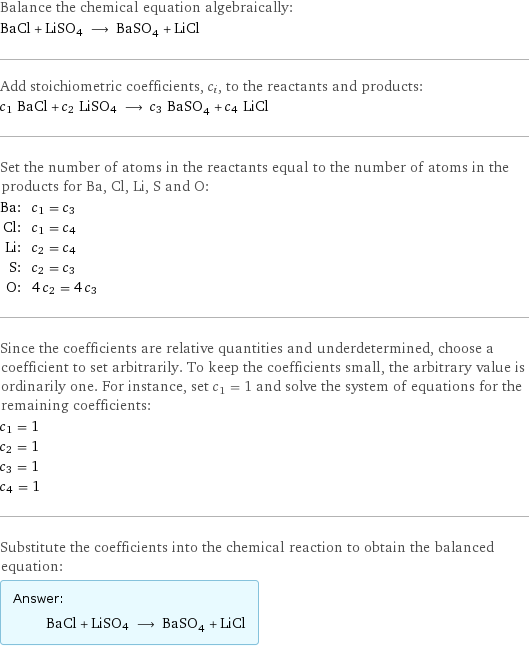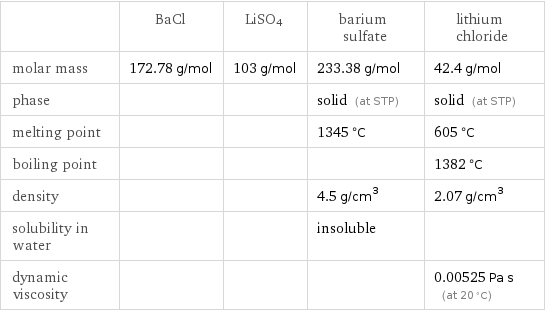Input interpretation

BaCl + LiSO4 ⟶ BaSO_4 barium sulfate + LiCl lithium chloride
Balanced equation

Balance the chemical equation algebraically: BaCl + LiSO4 ⟶ BaSO_4 + LiCl Add stoichiometric coefficients, c_i, to the reactants and products: c_1 BaCl + c_2 LiSO4 ⟶ c_3 BaSO_4 + c_4 LiCl Set the number of atoms in the reactants equal to the number of atoms in the products for Ba, Cl, Li, S and O: Ba: | c_1 = c_3 Cl: | c_1 = c_4 Li: | c_2 = c_4 S: | c_2 = c_3 O: | 4 c_2 = 4 c_3 Since the coefficients are relative quantities and underdetermined, choose a coefficient to set arbitrarily. To keep the coefficients small, the arbitrary value is ordinarily one. For instance, set c_1 = 1 and solve the system of equations for the remaining coefficients: c_1 = 1 c_2 = 1 c_3 = 1 c_4 = 1 Substitute the coefficients into the chemical reaction to obtain the balanced equation: Answer: | | BaCl + LiSO4 ⟶ BaSO_4 + LiCl
Structures

BaCl + LiSO4 ⟶ +
Names

BaCl + LiSO4 ⟶ barium sulfate + lithium chloride
Equilibrium constant
![Construct the equilibrium constant, K, expression for: BaCl + LiSO4 ⟶ BaSO_4 + LiCl Plan: • Balance the chemical equation. • Determine the stoichiometric numbers. • Assemble the activity expression for each chemical species. • Use the activity expressions to build the equilibrium constant expression. Write the balanced chemical equation: BaCl + LiSO4 ⟶ BaSO_4 + LiCl Assign stoichiometric numbers, ν_i, using the stoichiometric coefficients, c_i, from the balanced chemical equation in the following manner: ν_i = -c_i for reactants and ν_i = c_i for products: chemical species | c_i | ν_i BaCl | 1 | -1 LiSO4 | 1 | -1 BaSO_4 | 1 | 1 LiCl | 1 | 1 Assemble the activity expressions accounting for the state of matter and ν_i: chemical species | c_i | ν_i | activity expression BaCl | 1 | -1 | ([BaCl])^(-1) LiSO4 | 1 | -1 | ([LiSO4])^(-1) BaSO_4 | 1 | 1 | [BaSO4] LiCl | 1 | 1 | [LiCl] The equilibrium constant symbol in the concentration basis is: K_c Mulitply the activity expressions to arrive at the K_c expression: Answer: | | K_c = ([BaCl])^(-1) ([LiSO4])^(-1) [BaSO4] [LiCl] = ([BaSO4] [LiCl])/([BaCl] [LiSO4])](../image_source/3a51a88888ddbd4b09fa8c7e40fde5d4.png)
Construct the equilibrium constant, K, expression for: BaCl + LiSO4 ⟶ BaSO_4 + LiCl Plan: • Balance the chemical equation. • Determine the stoichiometric numbers. • Assemble the activity expression for each chemical species. • Use the activity expressions to build the equilibrium constant expression. Write the balanced chemical equation: BaCl + LiSO4 ⟶ BaSO_4 + LiCl Assign stoichiometric numbers, ν_i, using the stoichiometric coefficients, c_i, from the balanced chemical equation in the following manner: ν_i = -c_i for reactants and ν_i = c_i for products: chemical species | c_i | ν_i BaCl | 1 | -1 LiSO4 | 1 | -1 BaSO_4 | 1 | 1 LiCl | 1 | 1 Assemble the activity expressions accounting for the state of matter and ν_i: chemical species | c_i | ν_i | activity expression BaCl | 1 | -1 | ([BaCl])^(-1) LiSO4 | 1 | -1 | ([LiSO4])^(-1) BaSO_4 | 1 | 1 | [BaSO4] LiCl | 1 | 1 | [LiCl] The equilibrium constant symbol in the concentration basis is: K_c Mulitply the activity expressions to arrive at the K_c expression: Answer: | | K_c = ([BaCl])^(-1) ([LiSO4])^(-1) [BaSO4] [LiCl] = ([BaSO4] [LiCl])/([BaCl] [LiSO4])
Rate of reaction
![Construct the rate of reaction expression for: BaCl + LiSO4 ⟶ BaSO_4 + LiCl Plan: • Balance the chemical equation. • Determine the stoichiometric numbers. • Assemble the rate term for each chemical species. • Write the rate of reaction expression. Write the balanced chemical equation: BaCl + LiSO4 ⟶ BaSO_4 + LiCl Assign stoichiometric numbers, ν_i, using the stoichiometric coefficients, c_i, from the balanced chemical equation in the following manner: ν_i = -c_i for reactants and ν_i = c_i for products: chemical species | c_i | ν_i BaCl | 1 | -1 LiSO4 | 1 | -1 BaSO_4 | 1 | 1 LiCl | 1 | 1 The rate term for each chemical species, B_i, is 1/ν_i(Δ[B_i])/(Δt) where [B_i] is the amount concentration and t is time: chemical species | c_i | ν_i | rate term BaCl | 1 | -1 | -(Δ[BaCl])/(Δt) LiSO4 | 1 | -1 | -(Δ[LiSO4])/(Δt) BaSO_4 | 1 | 1 | (Δ[BaSO4])/(Δt) LiCl | 1 | 1 | (Δ[LiCl])/(Δt) (for infinitesimal rate of change, replace Δ with d) Set the rate terms equal to each other to arrive at the rate expression: Answer: | | rate = -(Δ[BaCl])/(Δt) = -(Δ[LiSO4])/(Δt) = (Δ[BaSO4])/(Δt) = (Δ[LiCl])/(Δt) (assuming constant volume and no accumulation of intermediates or side products)](../image_source/badd54d750998bd27adc06da0c2506d5.png)
Construct the rate of reaction expression for: BaCl + LiSO4 ⟶ BaSO_4 + LiCl Plan: • Balance the chemical equation. • Determine the stoichiometric numbers. • Assemble the rate term for each chemical species. • Write the rate of reaction expression. Write the balanced chemical equation: BaCl + LiSO4 ⟶ BaSO_4 + LiCl Assign stoichiometric numbers, ν_i, using the stoichiometric coefficients, c_i, from the balanced chemical equation in the following manner: ν_i = -c_i for reactants and ν_i = c_i for products: chemical species | c_i | ν_i BaCl | 1 | -1 LiSO4 | 1 | -1 BaSO_4 | 1 | 1 LiCl | 1 | 1 The rate term for each chemical species, B_i, is 1/ν_i(Δ[B_i])/(Δt) where [B_i] is the amount concentration and t is time: chemical species | c_i | ν_i | rate term BaCl | 1 | -1 | -(Δ[BaCl])/(Δt) LiSO4 | 1 | -1 | -(Δ[LiSO4])/(Δt) BaSO_4 | 1 | 1 | (Δ[BaSO4])/(Δt) LiCl | 1 | 1 | (Δ[LiCl])/(Δt) (for infinitesimal rate of change, replace Δ with d) Set the rate terms equal to each other to arrive at the rate expression: Answer: | | rate = -(Δ[BaCl])/(Δt) = -(Δ[LiSO4])/(Δt) = (Δ[BaSO4])/(Δt) = (Δ[LiCl])/(Δt) (assuming constant volume and no accumulation of intermediates or side products)
Chemical names and formulas

| BaCl | LiSO4 | barium sulfate | lithium chloride formula | BaCl | LiSO4 | BaSO_4 | LiCl Hill formula | BaCl | LiO4S | BaO_4S | ClLi name | | | barium sulfate | lithium chloride IUPAC name | | | barium(+2) cation sulfate | lithium chloride
Substance properties

| BaCl | LiSO4 | barium sulfate | lithium chloride molar mass | 172.78 g/mol | 103 g/mol | 233.38 g/mol | 42.4 g/mol phase | | | solid (at STP) | solid (at STP) melting point | | | 1345 °C | 605 °C boiling point | | | | 1382 °C density | | | 4.5 g/cm^3 | 2.07 g/cm^3 solubility in water | | | insoluble | dynamic viscosity | | | | 0.00525 Pa s (at 20 °C)
Units
